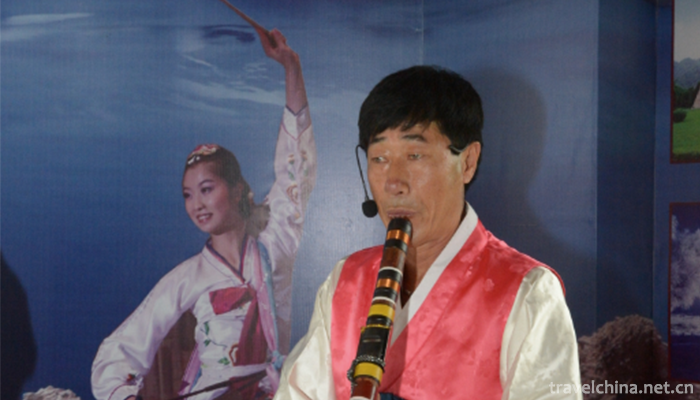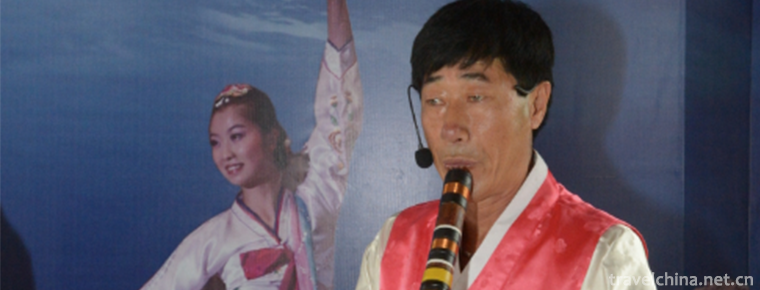Korean Dongxiao Music
Korean Dongxiao Music
The Koguryo History Music Records records that Dongxiao belonged to the musical instruments of the Tang Dynasty in China. During the period of Shizong in the Li Dynasty, it was introduced from West Asia to the Korean Peninsula via China. It is a unique and most representative traditional instrument of the Korean nationality in China. It has a history of 1500 years. According to historical records, in the middle of the fourth century, Gaogouli murals, there have been scenes of playing "Xiao" as an instrument. Since the 14th century, Xiao has been improved into Dongxiao and used in music practice. It has gradually become a traditional instrument of the Korean nation.
On June 7, 2008, Korean Dongxiao Music was approved by the State Council to be included in the second batch of national intangible cultural heritage list.
historical origin
As one of the most popular instruments among Korean people, Dongxiao (also known by scholars as tube xiao) plays an important role in the inheritance and dissemination of Korean folk music with its unique tone, performance style and artistic style. However, from the perspective of academic research of ethnomusicology, it has not attracted enough attention for a long time. This paper analyses and summarizes the characteristics, social functions and background of such musical cultural phenomena. On the basis of collecting data and field investigation as widely as possible, it combs and studies Korean Dongxiao and Dongxiao music with the research methods of Ethnology and musical morphology. The Dongxiao music and its folk activities in Mijiang Township of Hunchun City in Yanbian Korean Autonomous Prefecture of Jilin Province were investigated in detail. Through investigation and comprehensive study of literature, this paper traces the Korean national origin and Dongxiao music, and takes "Dongxiao Township" of Mijiang River as a typical case, the characteristics of Korean Dongxiao music.
artistic characteristics
In June 2008, Korean Dongxiao music was listed in the second batch of national intangible cultural heritage list.
Korean folk music, with its distinct characteristics, is unique in the music of ethnic minorities in China. It keeps the national style well and shows its tenacious vitality. However, with the development of society, like many other forms of folk music in China, the survival and development of Korean folk music is also facing unprecedented severe test.
Inheritance significance
Mijiang Township in Hunchun City is a well-known "Korean Dongxiao Township". Korean Dongxiao Art was listed in the national intangible cultural heritage list in 2008, and was awarded the title of "Town of Chinese Folk Culture and Art" by the Ministry of Culture of the People's Republic of China, and then awarded the title of "Town of Chinese Korean Dongxiao Art" by the Association of Chinese Folk Literators and Artists.
In order to further enhance the cultural atmosphere and influence of Mijiang Township and promote the construction of spiritual civilization in the whole town, Mijiang Township spontaneously organized Dongxiao fans to learn Dongxiao, practice popular tunes and rehearsal programs, and established a Dongxiao Association composed of more than 70 members. Mijiang Village, Mijiang Township, has a resident force. The development history of Mijiang Village is always linked with this force. In 1996, the village and the army formally formed a military-civilian co-construction unit. With concerted efforts, the village actively carried out activities such as rural grass-roots organization construction, new rural construction, poverty alleviation and poverty alleviation. Teacher Li Jisong, a provincial inheritor of intangible cultural heritage, went into the barracks and organized officers and soldiers to learn Korean Dongxiao culture. The officers and soldiers of the army changed their curiosity to love Dongxiao music. They practised diligently in their spare time. In less than two months, they played a popular Korean folk song "Alirang". The team's enthusiasts said that the Dongxiao is a very attractive traditional Korean musical instrument, greatly enriching the spiritual and cultural life of the army, they will continue to practice the Dongxiao performance, carefully rehearse programs, and perform in festival activities.


-
1.Go BelieveGoubuli baozi
Goubuli steamed bun is a snack made of flour, pork and other materials. It was founded in 1858 (Xianfeng period of the Qing Dynasty).
Time 2018-11-14 -
2.Oriental Giant Turtle Garden
Located on the East Bank of Yehe River in Pingshan County, Hebei Province, the Oriental Giant Turtle Garden is near Xibaipo, a sacred revolutionary site, 35 kilometers east of Shijiazhuang
Time 2018-12-20 -
3.Lion Tower Tourist Area
Lion Tower Tourist City is located at the head of the cross street of Yanggu County Town. It was built in Jingyou of the Northern Song Dynasty for three years.
Time 2019-02-08 -
4.Folk Stories in Guangyang Town
"Guangyang Folk Stories" is the general name of folklores and stories widely spread in Guangyang Town. Guangyang folk tales are popular in the local area.
Time 2019-05-01 -
5.Li Nationalitys Wood Drilling and Fire making Techniques
Li people's wood-drilling and fire-making skills, Hainan Province's local traditional handicraft, one of the national intangible cultural heritage.
Time 2019-05-13 -
6.Lu an drum
Luan drum is a traditional drum book and drum music form with distinct regional characteristics in the north, also known as the "old tune of Lu'an". It is named for its popularity in the are
Time 2019-05-15 -
7.Quanzhou North Pipe
Beiguan, also known as Beiqu, Xiaoqu, Quzi, is a kind of traditional folk silk and bamboo music widely spread in Quangang District, Quanzhou City, Fujian Province. China's Beiguan is now only distribu
Time 2019-06-11 -
8.The game of go
Go is a strategic two-player game. It was called "game" in ancient China and "Go" in the West. Popular in East Asian countries (China, Japan, Korea, Korea), is one of the four arts
Time 2019-06-26 -
9.Xiangyuan Drum Book
Xiangyuan Drum Book is a traditional opera in Shanxi Province. Originated in Xiangyuan, Shanxi Province, it is popular in Shangdang area. It is also called Guer Ci and Xiangyuan Tune. According to leg
Time 2019-07-06 -
10.Da Zang Temple
Located in the north of malkang County, dazang temple is about 500 kilometers away from Chengdu City and is located in the deep mountains above 3000 meters above sea level.
Time 2020-11-07 -
11.The origin of style of Chinese Cheongsam QiPao
The first one, represented by Zhou Xibao's the history of ancient Chinese costumes, believes that Qipao is directly developed from the robes of banner women in Qing Dynasty. However, some scholars believe that "although the cheongsam of the Republic of China
Time 2020-12-11 -
12.Convenient facilities and medical services of Chengdu Giant Panda Base
Chengdu Research Base of giant panda breeding has a tourist service center in the hall on the first floor of the museum, which can provide free convenience services such as microwave heating, drinking water hot water, baby carriage, wheelchair, walking stick, umbrella, needle and thread bag, etc.
Time 2020-12-13